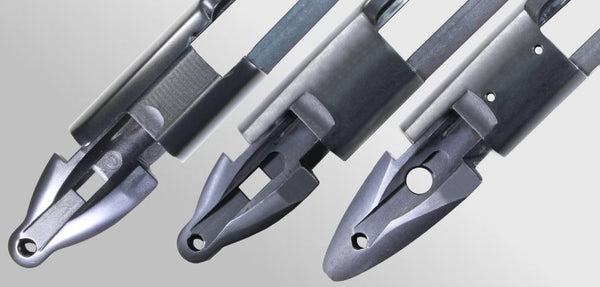Nearly every day my inbox contains inquiries from people looking for the right model 70 receiver on which to build their next rifle. Most people are aware of the 3 generations of pre-64 model 70 receiver, as shown in the photo below; in Winchester parlance, these are the "Type-I", "Type-II and "Type-III" receivers, (more commonly referred to as "pre-war", "transition", and "post-war"). However, many model 70 enthusiasts are not familiar with the differences within each generation, as they relate to the chambering a receiver is intended for.
One of the most common questions I get is from customers wondering where we are hiding the "short action" receivers. The trouble with this request is that Winchester did not produce a "short action" receiver in the pre 64 years. This Campfire article will address the most common misconceptions and answer the most common questions about the pre-64 receiver differences, as they relate to chambering.
Separate from the generational changes to the "styling" of the receivers, Winchester produced 3 different variations of the pre-64 receiver, based on chambering. They are the "standard", "short magnum" and "H&H magnum" receiver. All three of these receiver designs are identical in length and bolt pattern, the differences being in the size of the magazine box, the shape of the feed rails, and size of the top opening for cartridge ejection.
Here is a quick overview of how the three variations of model 70 receiver relate to chambering:
STANDARD: The "standard" receiver is used for all non-magnum chamberings from .22 Hornet right up through the .30-06. If you are building for anything other than a full-length magnum cartridge, this is the receiver you need. If you wish to shorten the action, a shorter bolt throw is accomplished via a short action extractor ring (more on this below).
SHORT MAGNUM: In the pre-64 era the term "short magnum" had a very different meaning than what we think of today. The "short magnum" receiver has a slightly wider magazine box and the feed rails are missing the characteristic step which is present the standard receiver - this is in order to accommodate the higher and wider shoulder of magnum cartridges. The short magnum receiver is used for all true magnum cartridges (belted magnums) other than the very long H&H magnums. Factory Winchester chamberings which used this receiver include the .264 Win mag, .300 Win mag, .338 Win mag, and 458 Win mag. Besides the differences described above, an easy way to identify a short magnum receiver is to look for the numbers ".458" stamped into the bottom of the recoil lug. This receiver will accommodate cartridges with an unfired length of up to 3.35 inches.
H&H MAGNUM: The "H&H Magnum" or "long magnum" receiver was designed to accommodate the exceptional length of the .300 H&H and .375 H&H magnum cartridges. This receiver accepts a longer magazine box and also has a longer case ejection opening. This receiver can eject an unfired round up to a staggering 3.7 inches in length and is ideal for any cartridge based on the H&H parent shell casing.

Returning to the question we introduced in the beginning of this article, let's get to the bottom of how Winchester produced "short action" pre-64 rifles, but without a short action receiver.
As discussed above, all pre 64 model 70 receivers are "long action" and are identical in length. Regardless of chambering, every model receiver has the exact the same screw spacing and (other than the tang style differences) will drop into the same stock inletting.
Winchester did, however, produce short action rifles in the pre-64 years. Unlike in more recent years, Winchester did not achieve this short action by creating a unique short action receiver. Shorter cartridge rifles like the .243 Win, .308 Win and .220 Swift use a standard receiver (the same as the .30-06 Sprg and .270 WCF), but with the throw of the bolt shortened by means of a special extractor ring and a unique, longer ejector. In this way, Winchester was able to shorten the throw of the bolt by about 1.5 inches, but still use the standard receiver.

There are other minor receiver variations which are primarily of interest to collectors, but knowing which generation and chambering design you need in a receiver will help get your rifle build off to a great start. pre64win.com has a wide variety of receivers in inventory and we would be thrilled to help you get your custom build project off the ground. You'll find our inventory of available receivers HERE.
If you'd like to build a custom rifle, but aren't sure where to start, shoot me a note; I'd be glad to talk about what's involved and what kinds of options are available to you. If you'd like a custom rifle built to your specifications, but really aren't interested in doing the build yourself, we'd be more than happy to quote you a price on a completed action, or a completed rifle, to your custom specifications.
Happy building!
Justin



https://essaywritingeie.com/ instant essay writer [url=https://essaywritingeie.com/ ]i need help writing my paper [/url] doing homework
https://chloroquinehydro.com/ where to buy hydroxychloroquine chloroquine phosphate canada hydroxychloroquine online chloroquine hydrochloride
https://predforteprednisone.com/ prednisone drops after cataract surgery [url=https://predforteprednisone.com/ ]prednisolone eye drops [/url] prednisone dose pack
gold fish casino slots online casinos casino games
https://isotroinisotretinoin.com/ what is accutane [url=https://isotroinisotretinoin.com/ ]isotretinoin [/url] buy accutane
Leave a comment